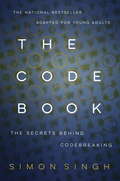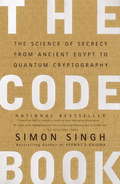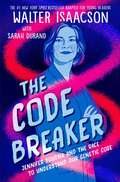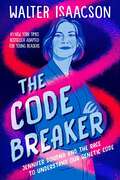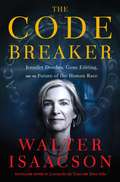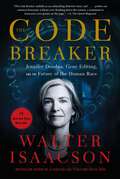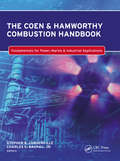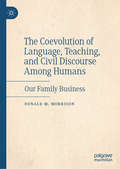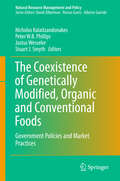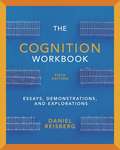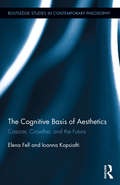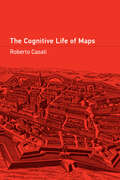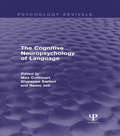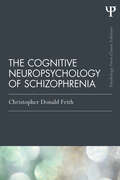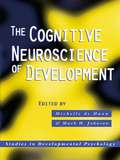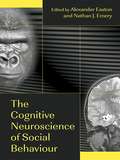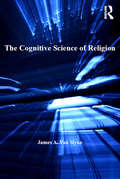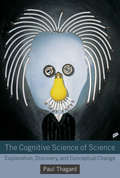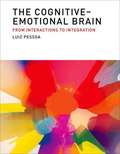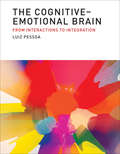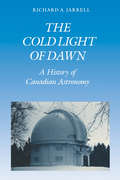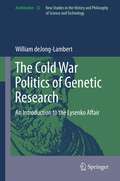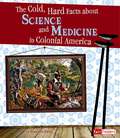- Table View
- List View
The Code Book for Young People
by Simon SinghFor those curious about Alan Turing, breaking Nazi Germany's Enigma Code, or The Imitation Game starring Benedict Cumberbatch and Keira Knightley, Simon Singh's The Code Book for Young People has all you need to know about the science of secrecy. Cryptography: the encoding and decoding of private information. And it is history's most fascinating story of intrigue and cunning. From Julius Caesar and his Caesar Cipher to the code used by Mary Queen of Scots and her conspiracy to the use of the Engima machine during the Second World War, Simon Singh follows the evolution of secret writing. Accessible, compelling, and timely, this international bestseller, now adapted for young people, is sure to make readers see the past--and the future--in a whole new way.From the Hardcover edition.
The Code Book: The Science of Secrecy from Ancient Egypt to Quantum Cryptography
by Simon SinghIn his first book since the bestselling Fermat's Enigma, Simon Singh offers the first sweeping history of encryption, tracing its evolution and revealing the dramatic effects codes have had on wars, nations, and individual lives. From Mary, Queen of Scots, trapped by her own code, to the Navajo Code Talkers who helped the Allies win World War II, to the incredible (and incredibly simple) logisitical breakthrough that made Internet commerce secure, The Code Book tells the story of the most powerful intellectual weapon ever known: secrecy.Throughout the text are clear technical and mathematical explanations, and portraits of the remarkable personalities who wrote and broke the world's most difficult codes. Accessible, compelling, and remarkably far-reaching, this book will forever alter your view of history and what drives it. It will also make yo wonder how private that e-mail you just sent really is.From the Trade Paperback edition.
The Code Breaker -- Young Readers Edition: Jennifer Doudna and the Race to Understand Our Genetic Code
by Walter IsaacsonWalter Isaacson&’s #1 New York Times bestselling history of our third scientific revolution: CRISPR, gene editing, and the quest to understand the code of life itself, is now adapted for young readers!When Jennifer Doudna was a sixth grader in Hilo, Hawaii, she came home from school one afternoon and found a book on her bed. It was The Double Helix, James Watson&’s account of how he and Francis Crick had discovered the structure of DNA, the spiral-staircase molecule that carries the genetic instruction code for all forms of life. This book guided Jennifer Doudna to focus her studies not on DNA, but on what seemed to take a backseat in biochemistry: figuring out the structure of RNA, a closely related molecule that enables the genetic instructions coded in DNA to express themselves. Doudna became an expert in determining the shapes and structures of these RNA molecules—an expertise that led her to develop a revolutionary new technique that could edit human genes. Today gene-editing technologies such as CRISPR are already being used to eliminate simple genetic defects that cause disorders such as Tay-Sachs and sickle cell anemia. For now, however, Jennifer and her team are being deployed against our most immediate threat—the coronavirus—and you have just been given a front row seat to that war.
The Code Breaker -- Young Readers Edition: Jennifer Doudna and the Race to Understand Our Genetic Code
by Walter IsaacsonWalter Isaacson&’s #1 New York Times bestselling history of our third scientific revolution: CRISPR, gene editing, and the quest to understand the code of life itself, is now adapted for young readers! When Jennifer Doudna was a sixth grader in Hilo, Hawaii, she came home from school one afternoon and found a book on her bed. It was The Double Helix, James Watson&’s account of how he and Francis Crick had discovered the structure of DNA, the spiral-staircase molecule that carries the genetic instruction code for all forms of life. This book guided Jennifer Doudna to focus her studies not on DNA, but on what seemed to take a backseat in biochemistry: figuring out the structure of RNA, a closely related molecule that enables the genetic instructions coded in DNA to express themselves. Doudna became an expert in determining the shapes and structures of these RNA molecules —an expertise that led her to develop a revolutionary new technique that could edit human genes. Today gene-editing technologies such as CRISPR are already being used to eliminate simple genetic defects that cause disorders such as Tay-Sachs and sickle cell anemia. For now, however, Jennifer and her team are being deployed against our most immediate threat—the coronavirus—and you have just been given a front row seat to that war.
The Code Breaker: Jennifer Doudna, Gene Editing, and the Future of the Human Race
by Walter IsaacsonThe bestselling author of Leonardo da Vinci and Steve Jobs returns with a gripping account of how the pioneering scientist Jennifer Doudna, along with her colleagues and rivals, launched a revolution that will allow us to cure diseases, fend off viruses, and enhance our children. In the spring of 2012, the Berkeley biochemist Jennifer Doudna and her collaborators turned a curiosity of nature into an invention that will transform the future of the human race: an easy-to-use tool that can edit DNA. Known as CRISPR, it opened a brave new world of medical miracles and moral questions. It has already been deployed to cure deadly diseases, fight the coronavirus pandemic of 2020, and make inheritable changes in the genes of babies. The development of CRISPR and the war against coronavirus will hasten our transition to the next great innovation revolution. The past half-century has been an information-technology era, based on the microchip, the computer, and the internet. Now we are entering an even more momentous era, a life-science revolution. Children who study digital coding will be surpassed by those who study the code of life. Should we use our new evolution-hacking powers to make us less susceptible to viruses and eliminate dreaded disorders? What a wonderful boon that would be! Right? And what about preventing congenital deafness or blindness? Or being very short? Or being depressed? Hmmm…How should we think about that? Should we allow parents, if they can afford it, to enhance the IQ or height or memory or muscles of their kids? After helping to discover CRISPR, Doudna became a leader in wrestling with these moral and policy issues. Her life story illustrates that the key to innovation is connecting basic science to our everyday lives—moving discoveries from our labs to our bedsides—in ways that respect our moral values. It&’s a thrilling detective tale that involves the most profound wonders of nature, from the origins of life to the future of our species.
The Code Breaker: Jennifer Doudna, Gene Editing, and the Future of the Human Race
by Walter IsaacsonThe bestselling author of Leonardo da Vinci and Steve Jobs returns with a gripping account of how Nobel Prize winner Jennifer Doudna and her colleagues launched a revolution that will allow us to cure diseases, fend off viruses, and have healthier babies. <P><P>When Jennifer Doudna was in sixth grade, she came home one day to find that her dad had left a paperback titled The Double Helix on her bed. She put it aside, thinking it was one of those detective tales she loved. When she read it on a rainy Saturday, she discovered she was right, in a way. As she sped through the pages, she became enthralled by the intense drama behind the competition to discover the code of life. Even though her high school counselor told her girls didn’t become scientists, she decided she would. <P><P>Driven by a passion to understand how nature works and to turn discoveries into inventions, she would help to make what the book’s author, James Watson, told her was the most important biological advance since his co-discovery of the structure of DNA. She and her collaborators turned a curiosity of nature into an invention that will transform the human race: an easy-to-use tool that can edit DNA. Known as CRISPR, it opened a brave new world of medical miracles and moral questions. The development of CRISPR and the race to create vaccines for coronavirus will hasten our transition to the next great innovation revolution. The past half-century has been a digital age, based on the microchip, computer, and internet. Now we are entering a life-science revolution. Children who study digital coding will be joined by those who study genetic code. Should we use our new evolution-hacking powers to make us less susceptible to viruses? What a wonderful boon that would be! And what about preventing depression? Hmmm…Should we allow parents, if they can afford it, to enhance the height or muscles or IQ of their kids? <P><P> After helping to discover CRISPR, Doudna became a leader in wrestling with these moral issues and, with her collaborator Emmanuelle Charpentier, won the Nobel Prize in 2020. Her story is a thrilling detective tale that involves the most profound wonders of nature, from the origins of life to the future of our species. <P><P><b>A New York Times Bestseller</b>
The Coen & Hamworthy Combustion Handbook: Fundamentals for Power, Marine & Industrial Applications (Industrial Combustion)
by Charles E. Baukal Stephen B. LondervilleThe rigorous treatment of combustion can be so complex that the kinetic variables, fluid turbulence factors, luminosity, and other factors cannot be defined well enough to find realistic solutions. Simplifying the processes, The Coen & Hamworthy Combustion Handbook provides practical guidance to help you make informed choices about fuels, burne
The Coevolution of Language, Teaching, and Civil Discourse Among Humans: Our Family Business
by Donald M. MorrisonThis book traces the evolutionary trajectory of language and teaching from the earliest periods of human evolution to the present day. The author argues that teaching is unique to humans and our ancestors, and that the evolution of teaching, language, and culture are the inextricably linked results of gene-culture coevolutionary processes. Drawing on related fields including archaeology, palaeontology, cultural anthropology, evolutionary psychology and linguistics, he makes the case that the need for joint attention and shared goals in complex adaptive strategies is the underlying driver for the evolution of language-like communication. This book will be of interest to students and scholars of these disciplines, as well as lay readers with an interest in human origins.
The Coexistence of Genetically Modified, Organic and Conventional Foods
by Stuart J. Smyth Nicholas Kalaitzandonakes Peter W. B. Phillips Justus WesselerSince their commercial introduction in 1996, genetically modified (GM) crops have been adopted by farmers around the world at impressive rates. In 2011, 180 million hectares of GM crops were cultivated by more than 15 million farmers in 29 countries. In the next decade, global adoption is expected to grow even faster as the research pipeline for new biotech traits and crops has increased almost fourfold in the last few years. The adoption of GM crops has led to increased productivity, while reducing pesticide use and the emissions of agricultural greenhouse gases, leading to broadly distributed economic benefits across the global food supply chain. Despite the rapid uptake of GM crops, the various social and economic benefits as well as the expanding rate innovation, the use of GM crops remains controversial in parts of the world. Despite the emergence of coexistence between GM, organic and conventional crops as a key policy and practical issue of global scale, there is no coherent literature that addresses it directly. Governments and market stakeholders in many countries are grappling with policy alternatives that settle conflicting property rights, minimize negative market externalities and associated liabilities, maximize the economic benefits of innovation and allow producer and consumer choice. This book intends to fill these needs with contributions from the top theoreticians, legal and economic analysts, policy makers and industry practitioners in the field. As the economics and policy of coexistence start to emerge as an separate subfield in agricultural, environmental and natural resource economics with an increasing number of scholars working on the topic, the book will also provide a comprehensive base in the literature for those entering the area, making it of interest to students, scholars and policy-makers alike.
The Cognition Workbooks: Essays, Demonstrations, and Explorations
by Daniel ReisbergThe Cognition Workbook contains engaging essays on research methodology and applications to topics like the legal system and education. Students are offered numerous hands-on activities to try themselves, including demonstrations of articulatory rehearsal loops, common errors in judgment and reasoning, the effect of practice on the cognitive unconscious, and many more. The new edition includes many new essays, activities, and demonstrations that focus on the real-world applications of cognitive psychology, and builds a bridge between the course and students' own concerns.
The Cognitive Basis of Aesthetics: Cassirer, Crowther, and the Future (Routledge Studies in Contemporary Philosophy)
by Elena Fell Ioanna KopsiaftiThis book seeks to fill a void in contemporary aesthetics scholarship by considering the cognitive features that make the aesthetic and artistic worthy of philosophical study. Aesthetic cognition has been largely abandoned by analytical philosophy, which instead tends to focus its attention on the ‘non-exhibited’ properties of artwork or issues concerning semantic and syntactic structure. The Cognitive Basis of Aesthetics innovatively seeks to correct the marginalization of aesthetics in analytical philosophy by reinterpreting aesthetic cognition through an integration of Ernst Cassirer’s philosophy of symbolic forms with Paul Crowther’s theory of imagination and philosophy of art. This integration has three important outcomes: 1) it explains why the aesthetic and artistic constitute a unique form of knowledge; 2) it shows the role this plays in the formation of aesthetics as a discipline; and 3) it describes why aesthetic cognition is so deeply engaging. This book’s unique theoretical approach engages with important works of visual, conceptual, and digital art, as well as literature, music, and theatre.
The Cognitive Life of Maps
by Roberto CasatiThe &“mapness of maps&”—how maps live in interaction with their users, and what this tells us about what they are and how they work.In a sense, maps are temporarily alive for those who design, draw, and use them. They have, for the moment, a cognitive life. To grapple with what this means—to ask how maps can be alive, and what kind of life they have—is to explore the core question of what maps are. And this is what Roberto Casati does in The Cognitive Life of Maps, in the process assembling the conceptual tools for understanding why maps have the power they have, why they are so widely used, and how we use (and misuse) them.Drawing on insights from cognitive science and philosophy of mind, Casati considers the main claims around what maps are and how they work—their specific syntax, peculiar semantics, and pragmatics. He proposes a series of steps that can lead to a precise theory of maps, one that reveals what maps have in common with diagrams, pictures, and texts, and what makes them different. This minimal theory of maps helps us to see maps nested in many cognitive artifacts—clock faces, musical notation, writing, calendars, and numerical series, for instance. It also allows us to tackle the issue of the territorialization of maps—to show how maps can be used to draw specific spatial inferences about territories. From the mechanics of maps used for navigation to the differences and similarities between maps and pictures and models, Casati's ambitious work is a cognitive map in its own right, charting the way to a new understanding of what maps mean.
The Cognitive Neuropsychology of Language (Psychology Revivals)
by Max Coltheart Giuseppe Sartori Remo JobDamage to the brain can impair language in many different ways, severely harming some linguistic functions whilst sparing others. To achieve some understanding of the apparently bewildering diversity of language disorders, it is necessary to interpret impaired linguistic performance by relating it to a model of normal linguistic performance. Originally published in 1987, this book describes the application of such models of normal language processing to the interpretation of a wide variety of linguistic disorders. It deals with both the production and the comprehension of language, with language at both the sentence and the single-word level, with written as well as with spoken language and with acquired as well as with developmental disorders.
The Cognitive Neuropsychology of Schizophrenia (Psychology Press & Routledge Classic Editions)
by Christopher Donald FrithThis is a classic edition of Christopher Frith’s award winning book on cognitive neuropsychology and schizophrenia, which now includes a new introduction from the author. The book explores the signs and symptoms of schizophrenia using the framework of cognitive neuropsychology, looking specifically at the cognitive abnormalities that underlie these symptoms. The book won the British Psychological Society book award in 1996, and is now widely seen as a classic in the field of brain disorders. The new introduction sees the author reflect on the influence of his research and the subsequent developments in the field, more than 20 years since the book was first published.
The Cognitive Neuroscience of Development: The Role Of Experience And The Developing Brain (Studies in Developmental Psychology)
by Michelle De Haan Mark H. JohnsonHow are the experiences of childhood incorporated into the structures of the developing brain, and how do these changes in the brain influence behaviour? This is one of the many questions motivating research in the relatively new field of developmental cognitive neuroscience. This book provides an extensive overview of the methods used to study such questions, and a thorough investigation into the emerging interface between neurobiological and psychological perspectives in the study of typical and atypical cognitive behaviour. The Cognitive Neuroscience of Development is a collection of essays written by international experts in the field. It covers not only traditional topics such as language, attention and memory development, but also includes individual chapters covering the theories of neurocognitive development and methods of studying brain activity in young infants and children. There are additional chapters on hormonal influences on brain and behavioural development, gender differences in the brain, and genetic disorders.This exceptional series of contributions surveys the study of both cognitive and neural development. The book takes into account brain architecture as well as the behavioural context of development, thus it succeeds in integrating the multiple methods and domains of research that have previously been studied in a more fragmented way. It will be invaluable to upper level students as well as researchers and teachers in Psychology, Neuroscience, Cognitive Science, Paediatrics and related fields.
The Cognitive Neuroscience of Social Behaviour
by Alexander Easton Nathan J. EmeryThe potential for cognitive neuroscience to shed light on social behaviour is increasingly being acknowledged and is set to become an important new approach in the field of psychology. Standing at the vanguard of this development, The Cognitive Neuroscience of Social Behaviour provides a state-of-the-art contribution to a subject still in its infancy. Divided into three parts, the book presents an overview of research into neural substrates of social interactions, the cognitive neuroscience of social cognition and human disorders of social behaviour and cognition.
The Cognitive Science of Religion: Virtue Ethics, Exemplarity, And Cognitive Neuroscience (Routledge Science and Religion Series)
by James A. SlykeThe cognitive science of religion is a relatively new academic field in the study of the origins and causes of religious belief and behaviour. The focal point of empirical research is the role of basic human cognitive functions in the formation and transmission of religious beliefs. However, many theologians and religious scholars are concerned that this perspective will reduce and replace explanations based in religious traditions, beliefs, and values. This book attempts to bridge the reductionist divide between science and religion through examination and critique of different aspects of the cognitive science of religion and offers a conciliatory approach that investigates the multiple causal factors involved in the emergence of religion.
The Cognitive Science of Science: Explanation, Discovery, and Conceptual Change (Handbook Of The Philosophy Of Science Ser.)
by Paul ThagardA cognitive science perspective on scientific development, drawing on philosophy, psychology, neuroscience, and computational modeling.Many disciplines, including philosophy, history, and sociology, have attempted to make sense of how science works. In this book, Paul Thagard examines scientific development from the interdisciplinary perspective of cognitive science. Cognitive science combines insights from researchers in many fields: philosophers analyze historical cases, psychologists carry out behavioral experiments, neuroscientists perform brain scans, and computer modelers write programs that simulate thought processes.Thagard develops cognitive perspectives on the nature of explanation, mental models, theory choice, and resistance to scientific change, considering disbelief in climate change as a case study. He presents a series of studies that describe the psychological and neural processes that have led to breakthroughs in science, medicine, and technology. He shows how discoveries of new theories and explanations lead to conceptual change, with examples from biology, psychology, and medicine. Finally, he shows how the cognitive science of science can integrate descriptive and normative concerns; and he considers the neural underpinnings of certain scientific concepts.
The Cognitive-Emotional Brain: From Interactions to Integration
by Luiz PessoaThe idea that a specific brain circuit constitutes the emotional brain (and itscorollary, that cognition resides elsewhere) shaped thinking about emotion and the brain for manyyears. Recent behavioral, neuropsychological, neuroanatomy, and neuroimaging research, however,suggests that emotion interacts with cognition in the brain. In this book, Luiz Pessoa moves beyondthe debate over functional specialization, describing the many ways that emotion and cognitioninteract and are integrated in the brain. The amygdala is often viewed as thequintessential emotional region of the brain, but Pessoa reviews findings revealing that many of itsfunctions contribute to attention and decision making, critical components of cognitive functions. He counters the idea of a subcortical pathway to the amygdala for affective visual stimuli with analternate framework, the multiple waves model. Citing research on reward andmotivation, Pessoa also proposes the dual competition model, which explainsemotional and motivational processing in terms of their influence on competition processes at bothperceptual and executive function levels. He considers the broader issue of structure-functionmappings, and examines anatomical features of several regions often associated with emotionalprocessing, highlighting their connectivity properties. As new theoretical frameworks of distributedprocessing evolve, Pessoa concludes, a truly dynamic network view of the brain will emerge, in which"emotion" and "cognition" may be used as labels in the context of certain behaviors, but will notmap cleanly into compartmentalized pieces of the brain.
The Cognitive-Emotional Brain: From Interactions to Integration (The\mit Press Ser.)
by Luiz PessoaA study that goes beyond the debate over functional specialization to describe the ways that emotion and cognition interact and are integrated in the brain.The idea that a specific brain circuit constitutes the emotional brain (and its corollary, that cognition resides elsewhere) shaped thinking about emotion and the brain for many years. Recent behavioral, neuropsychological, neuroanatomy, and neuroimaging research, however, suggests that emotion interacts with cognition in the brain. In this book, Luiz Pessoa moves beyond the debate over functional specialization, describing the many ways that emotion and cognition interact and are integrated in the brain. The amygdala is often viewed as the quintessential emotional region of the brain, but Pessoa reviews findings revealing that many of its functions contribute to attention and decision making, critical components of cognitive functions. He counters the idea of a subcortical pathway to the amygdala for affective visual stimuli with an alternate framework, the multiple waves model. Citing research on reward and motivation, Pessoa also proposes the dual competition model, which explains emotional and motivational processing in terms of their influence on competition processes at both perceptual and executive function levels. He considers the broader issue of structure-function mappings, and examines anatomical features of several regions often associated with emotional processing, highlighting their connectivity properties. As new theoretical frameworks of distributed processing evolve, Pessoa concludes, a truly dynamic network view of the brain will emerge, in which "emotion" and "cognition" may be used as labels in the context of certain behaviors, but will not map cleanly into compartmentalized pieces of the brain.
The Cold Light of Dawn: A History of Canadian Astronomy
by Richard JarrellThe discovery in 1987 of a supernova brought to world attention the excellence of Canadian astronomers. As Richard Jarrell explains in this book, the path to excellence has been a long one. Although astronomy has been practised in this country from the earliest days of exploration, its professional status has slowly evolved in much the same way as has the nation itself. In the period of exploration and early settlement, the practical needs of navigators and surveyors were foremost. Astronomical practitioners – for many used astronomy but few were professional or even amateur astronomers – came from elsewhere. Only when Canada was a settled colony, halfway through the nineteenth century, did its own scientific needs emerge. By the century's end Canadian astronomy, socially and institutionally unique and independent, had been established: astronomers born and trained in Canada worked in their own organized and funded institutions. In the twentieth century the story is dominated by the Dominion Observatory, and, in higher education, the University of Toronto. The federal government remained the biggest actor, in employment and funding, first through the observatories, then the National Research Council. The expansion of universities greatly broadened the scope of Canadian astronomy, while the Royal Astronomical Society of Canada, local clubs, literature, planetariums, and museums kept the public informed. By the 1960s Canadian astronomy, though small in size, was as sophisticated as any in the world.
The Cold War Politics of Genetic Research
by William Dejong-LambertThis book uses the reaction of a number of biologists in the United States and Great Britain to provide an overview of one of the most important controversies in Twentieth Century biology, the "Lysenko Affair." The book is written for advanced undergraduate and graduate students of history/history of science. It covers a number of topics which are relevant to understanding the sources and dimensions of the Lysenko controversy, including the interwar eugenics movement, the Scopes Trial, the popularity of Lamarckism as a theory of heredity prior to the synthesis of genetics and Natural Selection, and the Cold War. The book focuses particularly on portrayals--both positive and negative--of Lysenko in the popular press in the U.S. and Europe, and thus by extension the relationship between scientists and society. Because the Lysenko controversy attracted a high level of interest among the lay community, it constitutes a useful historical example to consider in context with current topics that have received a similar level of attention, such as Intelligent Design or Climate Change.
The Cold, Hard Facts About Science And Medicine In Colonial America
by Elizabeth RaumTravel back to a time when: No one knew what germs were or that they made you sick. People believed the moon had magical powers. Step into the lives of the colonists, and learn the cold, hard facts about science and medicine in colonial America.
The Collaborative Era in Science: Governing The Network (Palgrave Advances In The Economics Of Innovation And Technology Ser.)
by Caroline S. WagnerIn recent years a global network of science has emerged as a result of thousands of individual scientists seeking to collaborate with colleagues around the world, creating a network which rises above national systems. The globalization of science is part of the underlying shift in knowledge creation generally: the collaborative era in science. Over the past decade, the growth in the amount of knowledge and the speed at which it is available has created a fundamental shift—where data, information, and knowledge were once scarce resources, they are now abundantly available. Collaboration, openness, customer- or problem-focused research and development, altruism, and reciprocity are notable features of abundance, and they create challenges that economists have not yet studied. This book defines the collaborative era, describes how it came to be, reveals its internal dynamics, and demonstrates how real-world practitioners are changing to take advantage of it. Most importantly, the book lays out a guide for policymakers and entrepreneurs as they shift perspectives to take advantage of the collaborative era in order to create social and economic welfare.
The Collagen Superfamily and Collagenopathies (Biology of Extracellular Matrix #8)
by Florence RuggieroThis book aims at providing insights into the collagen superfamily and the remarkable diversity of collagen function within the extracellular matrix. Additionally, the mechanisms underlying collagen-related diseases such as dystrophic epidermolysis bullosa, osteogenesis imperfecta, as well as collagen-related myopathies and neurological disorders are discussed.Collagens are the most abundant extracellular matrix proteins in organisms. Their primary function is to provide structural support and strength to cells and to maintain biomechanical integrity of tissues. However, collagens can no longer be considered just as structural proteins. They can act as extracellular modulators of signaling events and serve critical regulatory roles in various cell functions during embryonic development and adult homeostasis. Furthermore, collagens are associated with a broad spectrum of heritability-related diseases known as “collagenopathies” that affect a multitude of organs and tissues including sensorial organs.The book is a useful introduction to the field for junior scientists, interested in extracellular matrix research. It is also an interesting read for advanced scientists and clinicians working on collagens and collagenopathies, giving them a broader view of the field beyond their area of specialization.
